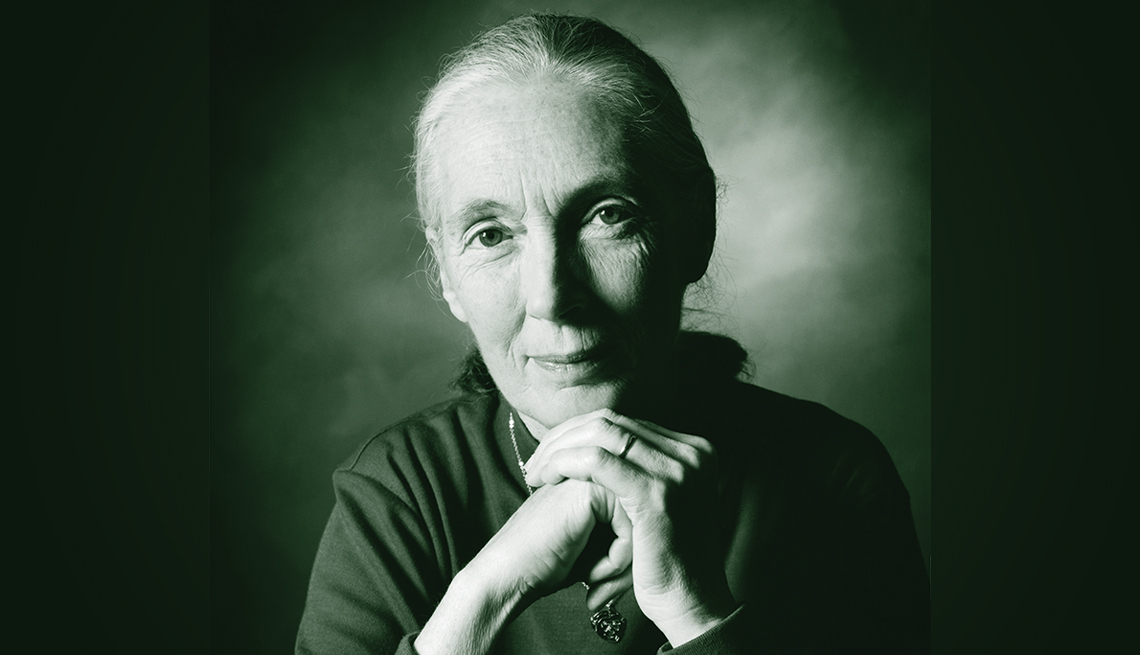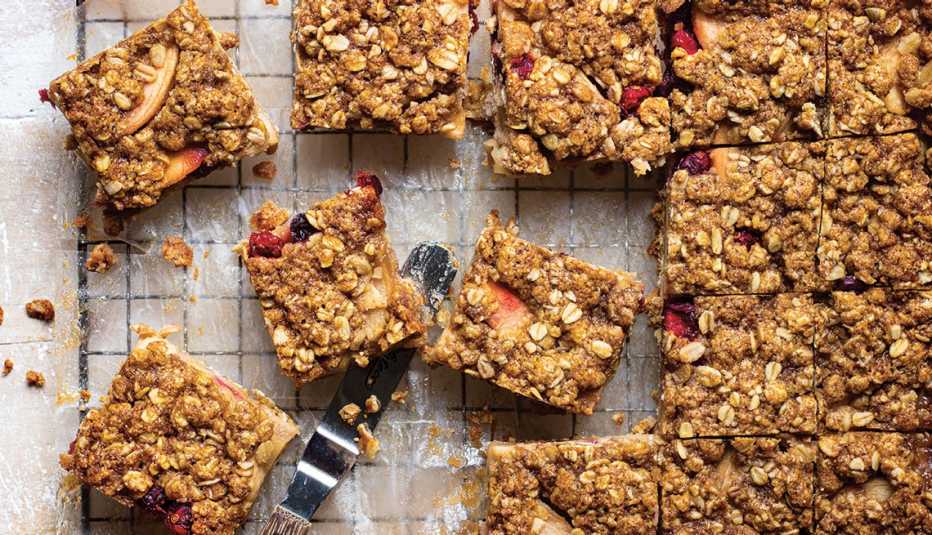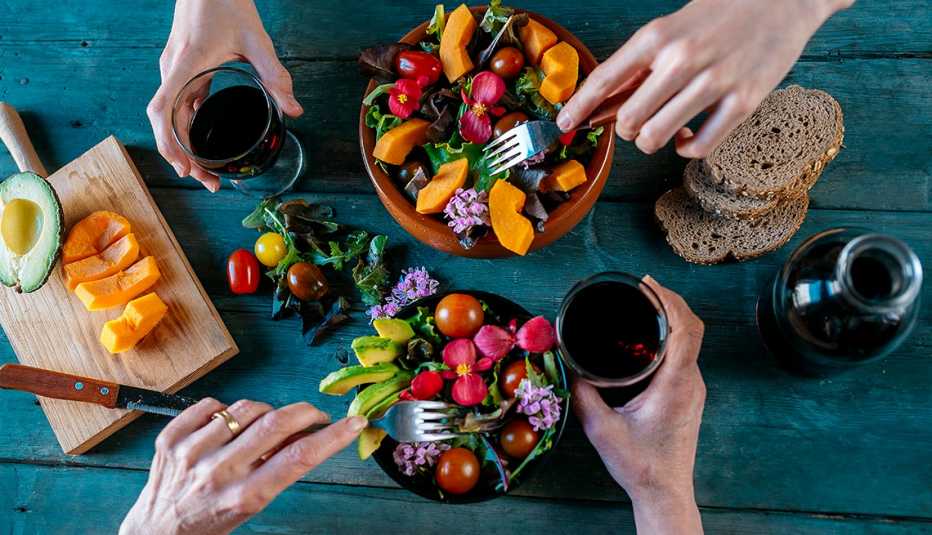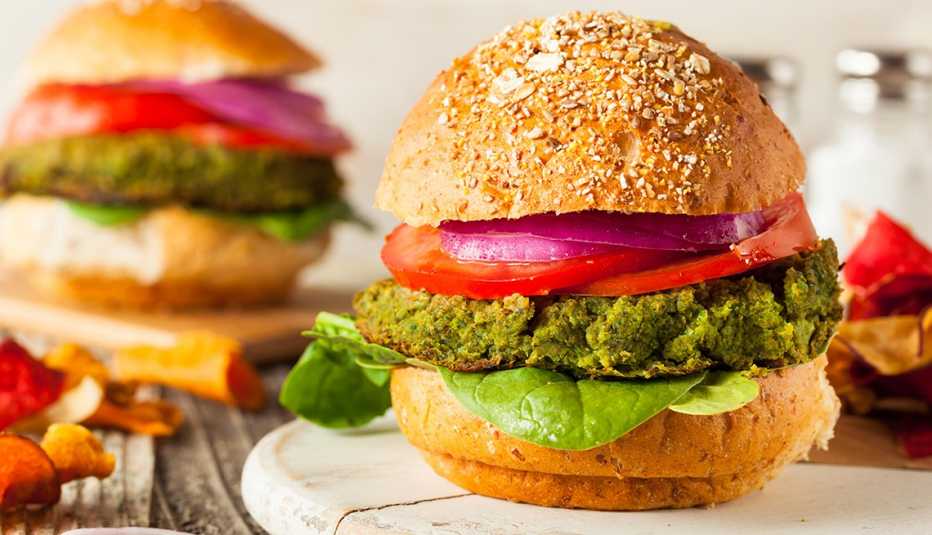Staying Fit
We all know Jane Goodall as the chimp lady: the woman who, at age 26, packing binoculars and a notebook, left her home in England for the wilds of what is now Tanzania to live with, study and ultimately protect chimpanzees. Now 86, Goodall is still going strong, advocating for both animal welfare and environmental stewardship.
Speaking from her childhood home in Bournemouth, England, which has become her central command during the pandemic, Goodall says she is now “virtual Jane, working probably three times harder than I did when traveling 300 days a year, spreading hope around the world."


AARP Membership— $12 for your first year when you sign up for Automatic Renewal
Get instant access to members-only products and hundreds of discounts, a free second membership, and a subscription to AARP the Magazine.
She is also spreading the message of plant-based eating. The Jane Goodall Institute's first cookbook ever, titled #EatMeatless: Good for Animals, the Earth & All, hits bookstores this month, offering up 80 plant-based recipes that are both healthy and inspiring: breakfast dishes, soups, salads, mains and desserts.

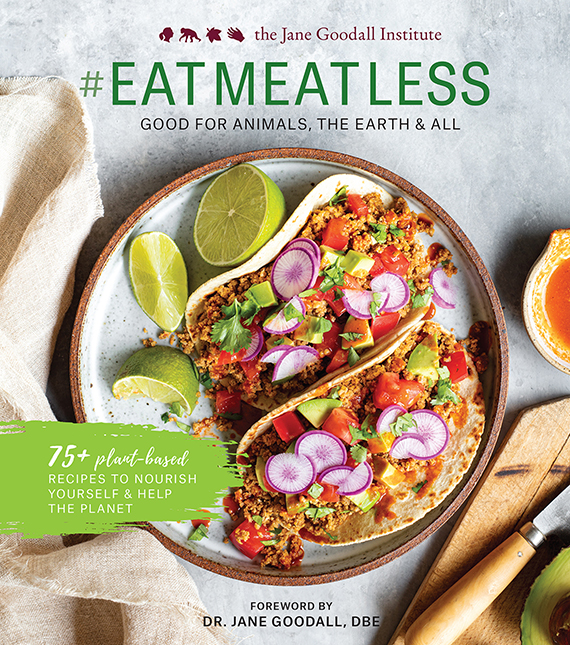
A longtime vegetarian and now vegan, Goodall — who wrote the cookbook's foreword and offers nuggets of wisdom throughout — shared why she and her eponymous institute decided to create this collection now: “It's becoming more and more clear that the obsession with eating meat and dairy products and eggs is totally destroying the environment. It's creating methane, it's wasting water, and it's bad for our health."
Goodall, whose studies in the ‘60s and ‘70s of chimps in Tanzania's Gombe Stream National Park (work that continues today) led many to view animals as sentient beings like us, grew up in the U.K. eating meat. But while on a flight in the late ‘60s, she read Peter Singer's book Animal Liberation and had an epiphany. “I looked at this meal they served me — it was a bit of chicken — and I realized that it represented fear, pain and death. And I thought, ‘I don't want anything to do with that.’ And that was the end of my eating any kind of meat."
Though her initial reasons, she says, were “ethical and purely about animals,” they are now also about the environment. She takes particular aim at the raising of animals on factory farms, which requires the clearing of huge swaths of habitat and the use of pesticides, fertilizer and lots of fossil fuels.
Plant-based eating, she says, isn't just better for the environment — it's also healthier. Along with cardiovascular benefits, Goodall points to growing research that links meat to human antibiotic resistance — and ultimately, she says, to superbugs.
For those of any age, Goodall stresses it's never too late to tweak your diet. She offers a simple suggestion for meat eaters: Start by going meatless one day a week. “Vegan food used to be tasteless and awful,” she says, but today “really good vegan cooking is some of the best I've ever tasted.” This cookbook (including the four excerpted recipes that follow) is a great place to start.

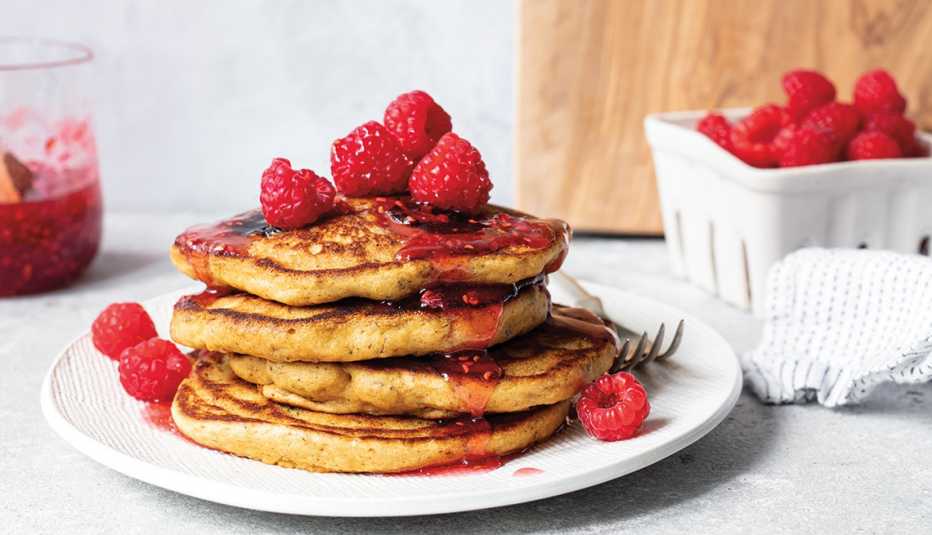
Banana Pancakes With Seasonal Fruit Syrup
White whole wheat flour is made from a variety of wheat that has a pale outer bran layer, so it looks like white flour but has all the benefits of whole grain wheat. If you can't find it, substitute whole wheat pastry flour. You can use a ripe banana for these pancakes, and it will caramelize nicely in the hot pan, a perfect foil for the fruity syrup.
Ingredients
- 2 cups fresh or thawed frozen berries or fruit, plus fresh berries for garnish
- ¼ cup maple syrup
- 1 ½ cups white whole wheat flour or whole wheat pastry flour
- 1 tablespoon brown sugar
- 1 teaspoon baking powder
- ½ teaspoon baking soda
- Sea salt
- 1 ½ cups plus 1 tablespoon unsweetened nondairy milk
- 2 tablespoons canola oil
- 1 tablespoon apple cider vinegar
- 2 tablespoons ground flax seeds
- 1 large, ripe banana, peeled and thinly sliced
To make the fruit syrup, in a 1-quart pot, combine the fruit and maple syrup, and set over medium heat. Bring to a boil and cook, stirring often, until the fruit is soft and the syrup is slightly thickened, 2-5 minutes. Keep warm over very low heat while you make the pancakes.
If desired, preheat the oven to 200°F. Place a heat-safe platter or pan in the oven to keep the cooked pancakes warm.
In a large bowl, whisk together the flour, brown sugar, baking powder, baking soda and 1/2 teaspoon salt. In a medium bowl, whisk together the nondairy milk, oil, vinegar and ground flax and let stand for 5 minutes for the flax to gel. Stir the nondairy milk mixture into the flour mixture just until all the flour is moistened.
Warm a griddle or a large nonstick frying pan over high heat. Spray with vegetable oil spray just before adding the batter. Stir the batter again, then use a 1/4-cup measure to scoop the batter onto the hot griddle, leaving 1 inch of space between the cakes. Place 3 slices of banana on top of each cake and tap down with a spatula to adhere. When the batter starts to bubble, reduce the heat to medium. When the edges of a pancake look dry and cooked and the surface is covered with holes, about 2 minutes, flip the cake. Cook for 2 minutes on the second side. Transfer the finished pancakes to the platter in the oven, if using, while you finish cooking the rest of the pancakes, using more vegetable oil spray as needed.
Place 3 to 4 pancakes on each plate, top with one-fourth of the fruit syrup and garnish with berries. Serve right away.
Makes four servings.

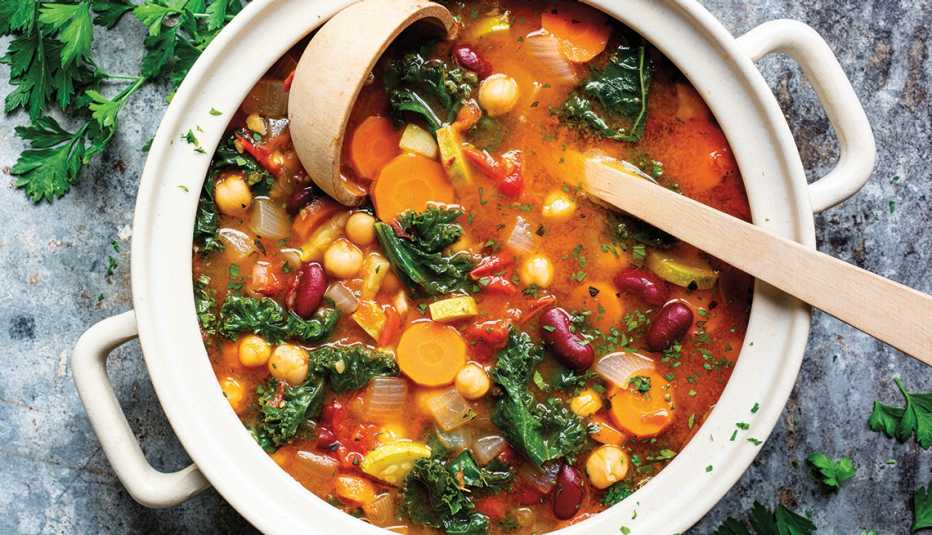
Summer Vegetable Minestrone
Peak-of-summer locally grown produce is the freshest and most nutritious, and practically seasons itself. All the cook needs to do is show off the vegetables’ vibrant flavors with an easy soup like this one. If you are making the soup ahead of time, don’t add the pasta, since it will soak up the broth and become mushy. Instead, wait and cook the pasta just before serving. Distribute it evenly into the bowls, and pour the reheated soup over the top.
Ingredients
- 2 tablespoons extra virgin olive oil
- 1 large yellow onion, chopped
- 2 large carrots, sliced
- 2 cloves garlic, chopped
- 1 teaspoon dried basil
- 1 teaspoon dried oregano
- ½ teaspoon fennel seeds
- 4 cups vegetable broth
- 4 large tomatoes, chopped, with their juices
- 1 15-ounce can chickpeas, drained and rinsed
- 1 15-ounce can kidney beans, drained and rinsed
- 1 zucchini, quartered lengthwise and sliced
- Sea salt and freshly ground pepper
- 1 bunch kale, ribs removed and thinly sliced, and leaves chopped
- ½ cup fresh flat-leaf parsley, chopped
- ½ cup orzo
In a large pot, warm the oil over medium-high heat. Add the onion and carrots and cook, stirring occasionally, until starting to soften, about 5 minutes. Add the garlic, basil, oregano, fennel seeds, broth, tomatoes and their juices, chickpeas, kidney beans, zucchini and ½ teaspoon each salt and pepper. Cover and bring to a boil, then reduce the heat to low and cook until the vegetables are tender, about 10 minutes. Remove from the heat. Stir in the kale and parsley and let stand, covered, until the kale is wilted, about 2 minutes.
Meanwhile, if using the orzo, bring a saucepan of salted water to a boil. Add the orzo and cook until al dente according to package instructions. Drain well. Stir the orzo into the finished soup.
Ladle the soup into bowls and serve right away.
Makes six servings.

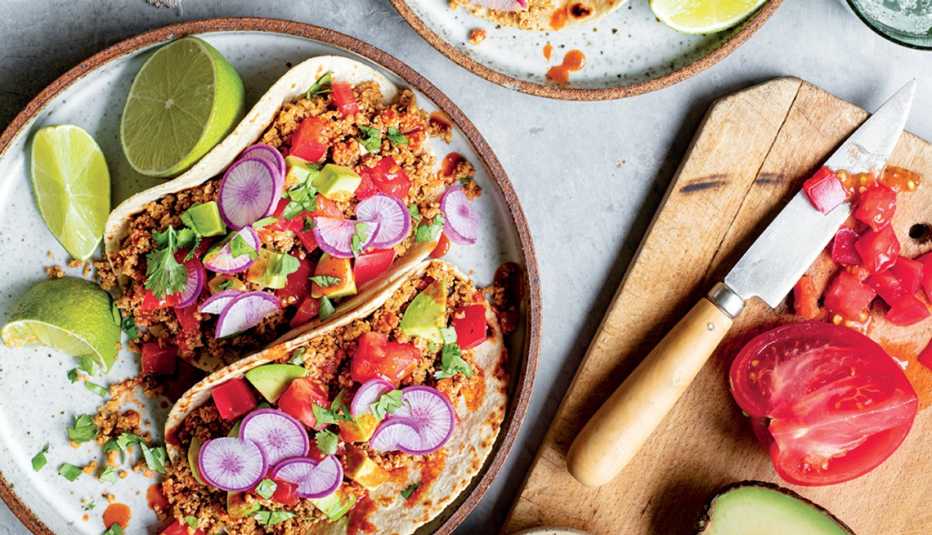
Cauliflower–Pumpkin Seed Tacos
With its texture and versatility, cauliflower makes a good stand-in for meat; its mellow flavor also pairs well with spices and seasonings. Pepitas come from a squash grown for its large hull-less seeds, which are very different from the seeds you scrape out of a Halloween pumpkin. They require less water to grow than most nuts, and contain protein, heart-healthy fats, and plenty of vitamins and minerals.
Ingredients
- 1 cup raw pumpkin seeds
- 2 cups cauliflower florets
- 2 Roma tomatoes, chopped
- 1 large jalapeño chili, seeded
- 3 cloves garlic, chopped
- 1 tablespoon olive oil
- ½ teaspoon dried sage
- ½ teaspoon chipotle powder
- 1 tablespoon tamari
- Sea salt
- 8 corn tortillas
- 1 ripe avocado, pitted, peeled and cubed
- Juice of ½ lime
- Hot sauce, for serving (optional)
In a food processor, process the pumpkin seeds until finely ground; scrape into a small bowl and set aside.
Place the cauliflower, half of the tomatoes, the jalapeño and garlic in the processor and pulse until minced.
In a large sauté pan, warm the oil over medium-high heat. Add the pumpkin seeds and cook, stirring, until lightly toasted, about 3 minutes.
Scrape the cauliflower mixture into the pan with the pumpkin seeds and cook, stirring often, until the mixture is soft and browned, about 8 minutes. Add the sage, chipotle powder, tamari and ½ teaspoon salt and stir until the pan is dry, 1–2 minutes. Transfer to a bowl.
In another bowl, toss together the remaining tomatoes, avocado, lime juice and a pinch of salt.



























































